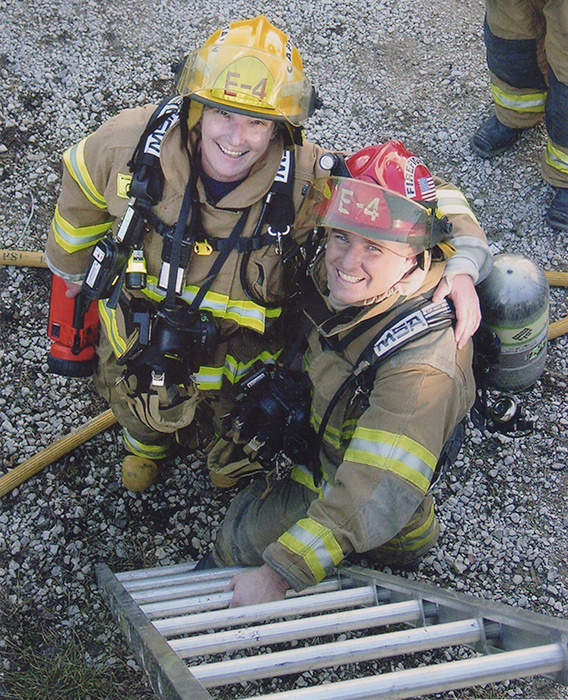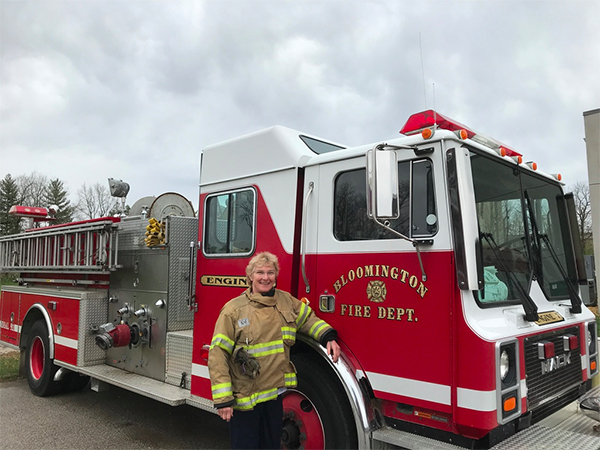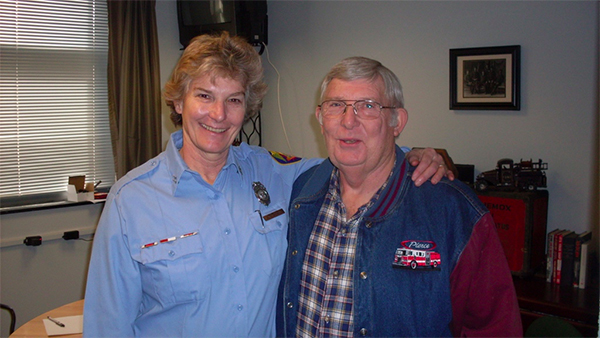
Jean Magrane (left), who became Bloomington’s first woman firefighter in 1987, with Greg Lucas at the “Jiffy Treat training day” in 2006. The fire department is often allowed to use condemned buildings for training purposes before the buildings are destroyed, such as the old Jiffy Treat on East Kirkwood Avenue. | Courtesy photo
Firefighters come to expect a breathless greeting every time they arrive on a scene. Whether it’s a house fire or a car wreck, someone’s bound to run up to the fire truck, pick out the man they think is in charge, and fill him in on what he needs to know — “Everybody’s out of the house!” or “My husband’s pinned in the driver’s seat!”
“This is information the officer in charge needs,” Jean Magrane says. She was a Bloomington firefighter for 27 years, eventually becoming a captain. The number of times she and her crew pulled up to a scene is beyond counting. “Never,” she says, “would they run up to me and tell me.”
Never, in other words, did they expect the man in charge to be a woman.
Magrane was the first female firefighter in the history of the Bloomington Fire Department (BFD). She joined in 1987, just as women were beginning, in real numbers, to join the ranks of professions, clubs, boards, and, yes, fire departments.
When Magrane was hired, she was known as “the new man” on the team and was responsible for all the dirty jobs and hazings that go along with that pitiably low rank. One of her jobs as the “new man” was to climb out on the second- and third-floor ledges to wash the station’s windows every Monday morning. She rose through the years, first becoming a sergeant and then captain. She stuck with the department until her retirement in 2014.
The year Magrane started, there was, to the best of her recollection, only one other female firefighter in the entire state, and that woman served in the Indianapolis Fire Department.
Now, it’s not terribly earthshaking to find a woman in a fire department, even in a small rural community. In fact, Bloomington itself would boast a female fire department chief in 1997, ten years after Magrane broke her ground here.
Magrane possesses a Hoosier drawl. She was born in Mishawaka, raised in South Bend, and has lived her entire adult life in Bloomington. She has a Midwestern economy with words as well. That quality kept her in good stead as she gradually worked her way into the tight-knit world of the fire house.
Firefighters live together in 24-hour shifts, sleeping together, cooking and eating together, washing the dishes, vacuuming, scrubbing the toilet. And then there’s the jarring blare of an alarm, an unpleasant electronic tone, an ugly buzz, audible for half a block outside the station, jerking firefighters out of their recliners as they watch a Hoosiers football game on TV or, worse, shocking them bolt upright in bed in the middle of the night — not knowing what terrible things they may see when they arrive at a scene.
People who share this life often form a club, an exclusive one. Outsiders need not apply. So when Jean Magrane was hired by the city of Bloomington in January 1987 to be part of the club, veteran club members, who were all men, weren’t celebrating.
“They didn’t like it,” Magrane says. “Prior to my reporting for work, they had a lot of meetings, wives included. The firefighters’ concern was, could I do the job, physically. The wives were worried about what I was going to sleep in.”
The comments, the narrowed eyes, the arms folded over her fellow firefighters’ chests, all conveyed to her their skepticism that she’d ever become one of them. She kept her mouth shut, for the most part, and waited.
As for her ability to do the job, it took her new colleagues a long time to pronounce her fit. “I remember the first fire when I was really accepted,” she says. “It was up on North Walnut. Kurt Cobain had just died. There was a woman who was very distraught about it. She set her apartment on fire and was running down the street naked.”
As BFD trucks arrived, many of the men gaped as they took in the scene, their eyes, Magrane, remembers, as wide as saucers. But then the crew got to work.

Magrane during a recent Girl Scouts fire camp that she helps organize. | Courtesy photo
“Our truck came around the back of the building,” Magrane says. “I went in through the back door. Now, the safety rules are, there have to be two firefighters, together at all times, going into a burning building. At the time, we didn’t have enough personnel. I went in alone with a fire hose.”
Meanwhile, Magrane’s battalion chief was breaking down the front door. He rushed inside, not knowing what to expect. What he saw would change the dynamic within the department.
After the fire was struck, after the trucks and the crews had returned to their stations, the battalion chief told the other men what he’d seen.
“There was Jean,” he said, approvingly, “lying on her back, putting the fire out.”
When her peers heard that she had battled a hotspot just as any good firefighter would do, Magrane was in. “It just seemed like bingo! From then on it was like I was okay.”
Cobain, by the way, died in April 1994, more than seven years after Magrane became a firefighter.
Magrane was no dewy-eyed kid when she joined the department. She was well into her 30s when she put on the uniform. An athletic kid in South Bend, she moved to Bloomington to get a teaching degree at Indiana University. She played volleyball and softball and swam for the Hoosiers.
She found a teaching gig in another town but realized she missed Bloomington. “I was sucked into the Bloomington vortex,” Magrane says. She came back to this town, got married, and moved through a succession of jobs.
“I did everything from digging ditches — literally — with the Utilities Department to working with the animal shelter to working at the youth shelter. I got a wastewater operators license. When the Dillman Road treatment plant opened, I was the first operator there. I saw the first pile of waste come through.”
Magrane wanted something more. “I got to be about 33 and I said to my husband, ‘Look, I’ve got to get a real job. I’m going nowhere.’ I thought I wanted to get into the outdoors. Wilderness companies were starting up. I had done Outward Bound.”
Then one day, she saw an ad in the paper. The BFD was looking for some new firefighters. Magrane noted a short sentence in the ad: Women encouraged to apply.
“I had known a couple of women who had tried to get on the department already but failed the physical agility test. I thought, ‘Okay, I’m a little stronger than they are so let me give it a try and see how it goes.’”
Magrane applied and was put through the gauntlet. She had to lift donut-rolled hoses up a certain height on steep ladders. She strapped on a heavy air tank and was shut inside a smoke-filled semitrailer truck and had to find her way out. She had to scale the tall, nearly vertical ladder on an old aerial truck — when she got to the top, she had to hook her leg around a rung and release her grip on the rails.
“I never had too much of an issue with heights, so that didn’t seem to matter,” Magrane says. Then her performance in one of the tests at the Assembly Hall parking lot iced it for her. She was to pick up a fire hose filled with sand and lug it or drag it a hundred yards. “I picked it up and started running with it,” she says.
The fire chief, a fellow named Larry Fleener (more about him in a bit) turned to the assistant standing next to him taking notes on a clipboard, and said, “I think we’ve just found our first female firefighter!”
Then there were the interviews. “I went before the Board of Safety,” Magrane says. “It was the last interview, and they asked, ‘Why do you want this job?’
“Well, I’d been an animal control officer and nobody’s ever happy to see you show up in that job. I worked at the youth shelter and that’s not a happy job either. I said, ‘I want a job where people are happy to see you when you show up.’ That’s the fire department, for sure.”

Magrane stands with her original capitan (who later became battalion chief), Bill Headley, on her retirement day. | Courtesy photo
Magrane was assigned to work in the then-main firehouse in the building that now is home to WFHB and parts of the Ivy Tech John Waldron Arts Center. This brought up the issue of where she’d sleep and what bathroom she’d use. Chief Fleener researched what other departments around the country had done to accommodate their first female firefighters. Many had spent a lot of money on renovations. Bloomington’s main firehouse at the time had but one bathroom in the upstairs sleeping quarters and the chief didn’t have the money to add a new one. “He bought a $1.49 hasp lock and had it put on the door,” Magrane says, laughing at the memory. “That was the renovation.”
Chief Fleener, fortunately, was all for Magrane. “He very much helped me,” she says. “He made sure I was assigned to the right crew. I had a wonderful captain who was the best guy I could have had. Chief Fleener set me up for success. He was always checking with me to make sure things were going well.”
Things went so well between the chief and Magrane that they became fast friends. In fact, after Magrane divorced her first husband in 1990, she and the chief got married in 2010.
“That was quite controversial,” she says. “A lot of guys were against it. But he was never my direct supervisor so that was not an issue. And, nowadays, look at all these shows that are on TV, like Chicago Fire. They’re all having romances in the fire department!”
Even with the chief squarely on her side, Magrane found the going rough. “It was a hard line for me to cross. A lot of women who started in the fire service at the time wanted to be ‘one of the guys.’ I came around, eventually, to say no to that. Women bring a different aspect to the firehouse. I went ahead and maintained that about myself.”
Over the years, that “new man” became just another trusted, accepted firefighter. When new women came aboard in the BFD, Magrane was held up as the standard. “The second woman that came on,” she recalls, “the guys would say, ‘Hey, Jean didn’t do this,’ or ‘Jean didn’t mind that.’” Magrane would take new female firefighters under her wing. “I always took them aside and [would] go out with them and have drinks with them and talk about things, what might make it easier for them.”
Magrane shrugs when asked if she’d ever feared for her life. Perhaps it’s her way of coping. There was, for instance, the time a Coca Cola bottling plant burned here. Her captain ordered her to run inside and drop a rope bag down from the second floor so she could haul up a charged hose. She had to figure out how to drop the rope bag through an oddly angled window.
“I’m standing there, looking at the window, just thinking, fifteen, twenty seconds,” she says. “So I run up there, I take one step into the room, and the whole roof collapses.
“If I hadn’t stood there fifteen or twenty seconds, I’d be across the room, throwing the rope bag down with the roof collapsing about me — wrong place, wrong time. That made me stop and think a little bit.”
Magrane witnessed a lot of changes in the BFD and in firefighting in general through her years in the service. When she started, she recalls hearing her colleagues say, as they ventured deeper into a burning building, “Hey, my ears are gettin’ hot; let’s get outta here!” By the time she retired in 2014, BFD crews were equipped with the latest thermal imaging devices. But there are the constants — “You know, it’s still all about puttin’ the wet stuff on the red stuff,” she says.
Women are a new constant. “Honestly, I did not meet another female firefighter for almost seven or eight years after I started,” Magrane says. “I read about a national conference — it was the second one ever — called Women in the Fire Service, held in Nashville, Tennessee. I asked the department and they let me go. I walked into this hotel conference room with 200 other women firefighters, Type-A personalities, and I’m like, ‘Oh my gosh!’ That was a wonderful experience, to be able to network and communicate with them, and say, ‘Hey, don’t you hate when they…?’”
When Magrane was captain, she and her crew would visit elementary schools around town, giving lectures to the students about fire safety. “I would introduce myself to the class, and say, ‘I’m the captain, here’s my driver, here’s my sergeant,’ and let them do their talks and demonstrations. At the end of one of these visits, the teacher kept saying, ‘Let’s thank the firemen today. Aren’t we glad the firemen came here?’ Normally that wouldn’t bother me, but I thought, This is a teacher! So I said, ‘Hey, boys and girls, I’ve got a question for you. If all these guys are firemen, what do you call me?’
“And this little girl in front raises her hand, and says, ‘The Boss!’”
[Editor’s note: Michael G. Glab’s full interview with Jean Magrane can be heard today on his radio show, Big Talk, which runs on WFHB (91.3 FM, 98.1 Bloomington, 100.7 Nashville, 106.3 Ellettsville) every Thursday at 5:30 p.m. and will be available, along with podcasts of past shows, at WFHB.org. Each of Glab’s monthly profiles for Limestone Post is based on one of his Big Talk interviews and will be posted on the same day that the interview airs on Big Talk.]

